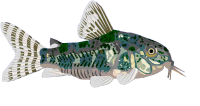Breeding Otos
Breeding Otos
Has anyone had any experience breeding these guys. Had mine for a few months now and lately one keeps rubbing up along side the other kind of strange site and they never leave eachothers side. Could this mean anything?
- WhitePine
- Posts: 354
- Joined: 07 Feb 2004, 07:54
- I've donated: $51.00!
- Location 1: Washington State
Did you see this article in Shane's World?
I had a pair with similar behaviors... but sadly one died shortly after I noticed them acting different.
Cheers, Whitepine
I had a pair with similar behaviors... but sadly one died shortly after I noticed them acting different.
Cheers, Whitepine
Cheers, Whitepine
River Tank with Rio HF 20 (1290 gph), Eheim 2236.
- Apon boivinianus, Bolbitis, Crypt balansae, Microsorum Windelov, Vallisneria americana, Crinum calamistratum, Nymphaea zenkerii, Anubias barterii.
River Tank with Rio HF 20 (1290 gph), Eheim 2236.
- Apon boivinianus, Bolbitis, Crypt balansae, Microsorum Windelov, Vallisneria americana, Crinum calamistratum, Nymphaea zenkerii, Anubias barterii.
-
Mike_Noren
- Posts: 1395
- Joined: 25 Jul 2003, 21:40
- I've donated: $30.00!
- My articles: 1
- My images: 37
- My cats species list: 5 (i:0, k:0)
- Spotted: 9
- Location 1: Sweden
- Location 2: Sweden
I don't think you'll find much info.
Otos are difficult to breed, so there's few reports about breeding, and most there are, are either accidental breedings where the aquarist never noticed anything until there suddenly were small otos all over the place, or cases of mistaken identity.
Several of the breeding reports on the net don't really concern otos at all, but species of Parotocinclus or Hisonotus.
Notably Otocinclus flexilis has a reputation for being easy to breed - because it is frequently confused with Hisonotus leucofrenatus (even e.g. http://www.scotcat.com gets them confused). To the best of my knowledge O. flexilis has never been bred in captivity.
I've tried breeding O. flexilis, and while I got plump females and some suspicious-looking behaviour, I never found the trigger to actually get them to spawn.
If I was to do another serious attempt at breeding otos, I'd probably try the small otos of the Otocinclus vittatus group. All well-documented breeding reports I've seen have been with otos of this group (e.g. this one: http://www.planetcatfish.com/shanesworld/s_r_256.php ).
Also, although Parotocinclus and Hisonotus probably are easier to breed, those genera are closely related to Otocinclus and checking their breeding reports may give useful hints on how to breed Otocinclus. E.g. you might find these interesting:
http://www.scotcat.com/articles/article20.html
http://www.planetcatfish.com/cotm/2004_12.php
Otos are difficult to breed, so there's few reports about breeding, and most there are, are either accidental breedings where the aquarist never noticed anything until there suddenly were small otos all over the place, or cases of mistaken identity.
Several of the breeding reports on the net don't really concern otos at all, but species of Parotocinclus or Hisonotus.
Notably Otocinclus flexilis has a reputation for being easy to breed - because it is frequently confused with Hisonotus leucofrenatus (even e.g. http://www.scotcat.com gets them confused). To the best of my knowledge O. flexilis has never been bred in captivity.
I've tried breeding O. flexilis, and while I got plump females and some suspicious-looking behaviour, I never found the trigger to actually get them to spawn.
If I was to do another serious attempt at breeding otos, I'd probably try the small otos of the Otocinclus vittatus group. All well-documented breeding reports I've seen have been with otos of this group (e.g. this one: http://www.planetcatfish.com/shanesworld/s_r_256.php ).
Also, although Parotocinclus and Hisonotus probably are easier to breed, those genera are closely related to Otocinclus and checking their breeding reports may give useful hints on how to breed Otocinclus. E.g. you might find these interesting:
http://www.scotcat.com/articles/article20.html
http://www.planetcatfish.com/cotm/2004_12.php
-
bronzefry
- Posts: 2198
- Joined: 31 Aug 2004, 16:01
- I've donated: $100.00!
- My articles: 6
- My images: 12
- My cats species list: 17 (i:0, k:0)
- My aquaria list: 7 (i:7)
- Spotted: 6
- Location 1: Sharon, Massachusetts, US
-
Mike_Noren
- Posts: 1395
- Joined: 25 Jul 2003, 21:40
- I've donated: $30.00!
- My articles: 1
- My images: 37
- My cats species list: 5 (i:0, k:0)
- Spotted: 9
- Location 1: Sweden
- Location 2: Sweden




